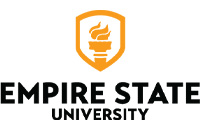How To Use Google Scholar
Google Scholar is a tool for finding scholarly articles. It covers all subject areas and includes content from many (but not all) publishers, as well as content in repositories and on web sites belonging to authors and research institutions.
Use Google Scholar With Your College Login To Access Full-text Articles
There is a way to search Google Scholar so that your search results list will have not only the articles, pre-prints, and post-prints that are available on the open web, but also links to full-text in the library databases, when it is available. To log into Google Scholar:
- Access Google Scholar via a link on the library web site, either on the Article Databases page or in a Subject Guide
- Go directly to https://scholar.google.com/
Then:
- In the second menu (under the header bar) click Settings.

- In the menu on the left side of the page, click Library Links.

- A text entry box and a menu of checkboxes will appear. If SUNY Empire is not one of the checkbox options, enter it into the text box and click the search button. Once it is one of the checkboxes, make sure there is a check in that box. Then click the Save button.

- Click Save again to get out of Settings.
- Now you can search Google Scholar and access full-text articles from the Empire Library subscriptions, as well as articles on the open web. You will find full-text links to the right of the search results. They will say "PDF from" or "HTML from" or "Full-text @ Library."

What Google Scholar Can't Do
Google Scholar can't do certain things that library databases are capable of, such as:
- Limit search results to only articles that are available as full-text
- Format article citations in APA, MLA, etc.
- Sort search results by different criteria
- Keep track of your search history
- Mark results from different searches and keep them in a folder
Are All Articles From Google Scholar Scholarly?
Despite the name, Google Scholar does have non-scholarly content. You will need to look at each article to determine whether it is scholarly. Here are some questions to ask:
- Is the author a subject expert?
- Is the article written for other experts?
- Was the article peer reviewed?
Click here for an explanation of scholarly versus popular information sources.
When To Use Google Scholar
| Use Google Scholar | Don't use Google Scholar |
| You know the title of the article you want | You want to search/browse the contents of a certain journal |
| You aren't sure which database to search | You're looking for books or ebooks |
| You're researching a topic that crosses into many different subject areas (multidisciplinary) | You're looking for newspapers, law journal articles, business reports, reference sources, or multimedia |
How To Use Google Scholar
Search tips
- If you mis-spell something, Google will offer suggestions.
- Put author:"Smith" to search for an article by author's last name.
- Google assumes that you want the AND operator all keywords. So if you search canine dog wolf, it's as if you were searching canine AND dog AND wolf.
- Google does use the OR operator. You can put (canine OR dog OR wolf).
- Google doesn't use the NOT operator. Instead, use the minus symbol like this. "canine" -teeth -tooth.
- Put quotation marks around exact keywords or phrases that you want in every search result. Otherwise Google's "Smart Search" will interpret them as "strong suggestions" rather than absolute requirements.
- Your search results are sorted by popularity, which is based on how many other web sites link to them, and in turn, how popular those linking web sites are. You can change this option in the column to the left of the results list.
- Once you've searched, you can limit your results by date using the column to the left of the results list.

Searching for a particular article
If you know the article you want, type in the information you have, such as key words from the title and the author's last name. Put keywords and phrases of two or more words in quotation marks.

Searching for articles on a topic
If you are searching by topic, type in keywords that describe it. Put keywords and phrases of two or more words in quotation marks.

Google also provides search tips.
Contact Us
-
Email:
librarian@sunyempire.edu -
Call 800-847-3000, ext. 2222






